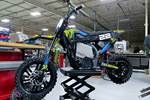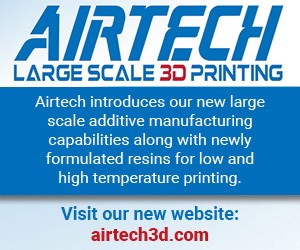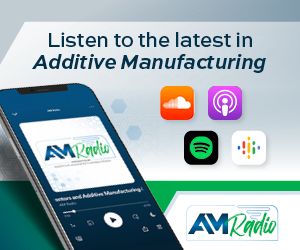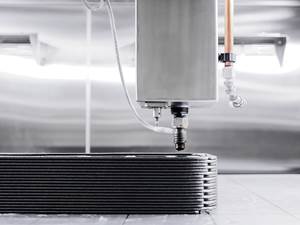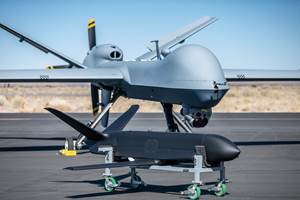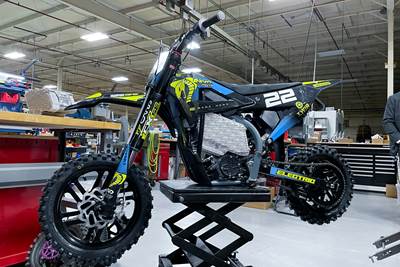Scroll to unlock this premium content if video does not play.
Minnesota-based additive manufacturer DI Labs is leveraging Multi Jet Fusion (MJF) 3D printing to deliver polymer parts for applications ranging from medical device enclosures to aftermarket automotive parts. Some of this work is ongoing, standardized serial production — but about 15% of it instead involves manufacturing customized products sold through its Threedom platform.
Welcome! You’ve unlocked premium content.
Gaining proficiency at delivering batches of slightly different, customized components for Threedom customers has had benefits for DI Labs’ primary scale production business. In the example shown in the video above (involving baskets needed for aeroponics agriculture), the company used the same approach to design and manufacturing of thousands of functional prototypes, arriving at the best design quickly so that manufacturing could begin on the product.
Related Resources
- More on DI Labs and its approach to both mass customization and mass production (coming soon)
- The Threedom store for custom aftermarket automotive accessories
- Mass customization enabled by AM
Transcript
Additive manufacturing has the capability to deliver mass customization, production where every single part can look a little bit different. The technology is no longer the hurdle. Now it's on to the engineering. How do you make design for mass customization scalable?
I'm Stephanie Hendrixson with Additive Manufacturing Media. I'm here at DI Labs in Wilmar, Minnesota, where they are working out how to deliver mass customization, how to design for mass customization using 3D printing at scale.
DI Labs is a 3D printing service provider. They are a product developer. They help customers take their ideas into production, often with 3D printing as the manufacturing method.
DI Labs uses a number of different polymer 3D printing platforms, including equipment from Stratasys, Carbon, Formlabs, but most of their production is done through Multi Jet Fusion, using machines like this from HP.
Most of their production is repeatable, ongoing jobs where the parts are identical. But in order to develop and prove out this idea of mass customization in 2020, they actually launched their own brand of products. It's called Threedom and it is aftermarket automotive accessories. So they started with key fobs, developing different designs for the fob that are accessible to users through their website. So you get a chance to sort of customize and choose exactly the keyfob that you want.
But in order to make this work, there was a lot of upfront engineering. They had to take into account all of the different constraints of this product. So where does the circuit board sit? Where does the key fit? What are all of the different features that are necessary to make this product work?
And then from there they were able to take a look at the customizable aspects of the keyfob things like color, shape, size, texturing and build that out into a suite of available options. And so ultimately, what they have created is a library of something like 50,000 SKUs that is accessible through an online configurator.
These designs were not necessarily created individually, but by choosing from the available options, you can get to 50,000 different combinations. They've expanded this idea into other car accessories, including things like door handles, hinge covers, key lock caps. And there's more to come.
But again, there was a lot of upfront engineering expertise and work that went into developing the system. Like the feature tree that gets you to 50,000 different options. What they're looking at now are ways of automating that iteration, using AI as a way to design these different iterations, and making it a more seamless experience for the user, the ultimate buyer.
In the future, it could be the case that you would go to the Threedom website and be able to upload an image of your dog or some other interests that you have, or even engage with, like an AI chat bot and describe exactly the design that you want, which could then work on the back end through those different constraints, those different parameters, and develop a design specifically for you that could then be manufactured here.
But this type of flexible, iterative, mass customization oriented thinking is also playing a role in their standard production work. So here's an example. This is a part for a customer that does aeroponic agriculture. So they grow lettuce. And they were changing their process over to an organic growing method, which meant changing the medium that the lettuce was grown in to a coconut-based material.
That material needed some structure and needed to be held in place. And so it needed these baskets that were 3D printed through MJF. But it wasn't a simple process.
So DI Labs went through 10 different iterations with this customer. They produced 1600 of these baskets in each iteration. Playing with things like the shape and the design of the openings, where the medium sits inside of the basket and various other factors, ultimately getting beyond just iterating based on the aesthetics or the ergonomics of the part, but actually getting to a more functional, better performing basket. The design that they ultimately produced for this customer through Multi Jet Fusion actually increased the yield of the lettuce by 30%.
So flexible, responsive, iterative design like this maybe with the help of AI is not just useful for mass customization where you're trying to just get the best iteration of one particular product. It is also useful for higher scale production, where you're trying to arrive at the best possible design as quickly as possible.
If you'd like to learn more about mass customization or additive for product development, visit us at AdditiveManufacturing.media and see the links in the video description. Thanks for watching.
Related Content
3D Printing with Plastic Pellets – What You Need to Know
A few 3D printers today are capable of working directly with resin pellets for feedstock. That brings extreme flexibility in material options, but also requires greater knowledge of how to best process any given resin. Here’s how FGF machine maker JuggerBot 3D addresses both the printing technology and the process know-how.
Read MoreWhat Is the Role of Directed Energy Deposition (DED)? We Are Still Discovering It
The applications go well beyond repair. Recently posted articles find many different use cases for DED, including its expanded application for production parts.
Read MoreVideo: 5" Diameter Navy Artillery Rounds Made Through Robot Directed Energy Deposition (DED) Instead of Forging
Big Metal Additive conceives additive manufacturing production factory making hundreds of Navy projectile housings per day.
Read MoreAt General Atomics, Do Unmanned Aerial Systems Reveal the Future of Aircraft Manufacturing?
The maker of the Predator and SkyGuardian remote aircraft can implement additive manufacturing more rapidly and widely than the makers of other types of planes. The role of 3D printing in current and future UAS components hints at how far AM can go to save cost and time in aircraft production and design.
Read MoreRead Next
New Electric Dirt Bike Is Designed for Molding, but Produced Through 3D Printing (Includes Video)
Cobra Moto’s new all-electric youth motocross bike could not wait for mold tooling. Parts have been designed so they can be molded eventually, but to get the bike to market, the production method now is additive manufacturing.
Read MoreWhy Customization at Mass-Market Scale Is Finally Possible With 3D Printing
Printer speed and materials coupled with scanning technologies are contributing to more affordable and accessible 3D printed, personalized goods.
Read MoreSurface Finishing Without Sacrificing Material Through MMP
The Micro Machining Process (MMP) Technology operated by BinC and its subsidiary MicroTek targets roughness frequencies to smooth surface roughness of metal parts, including those made through metal 3D printing.
Read More

.jpg;width=70;height=70;mode=crop)
